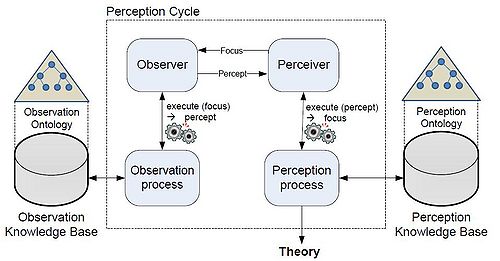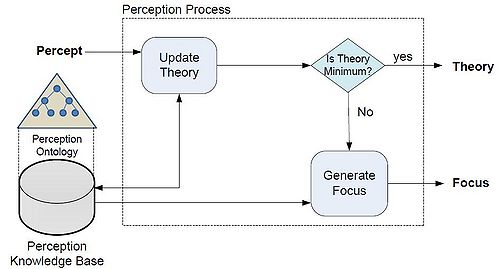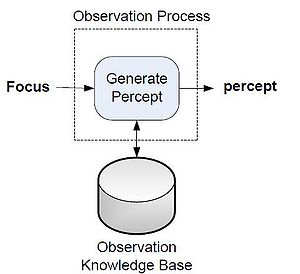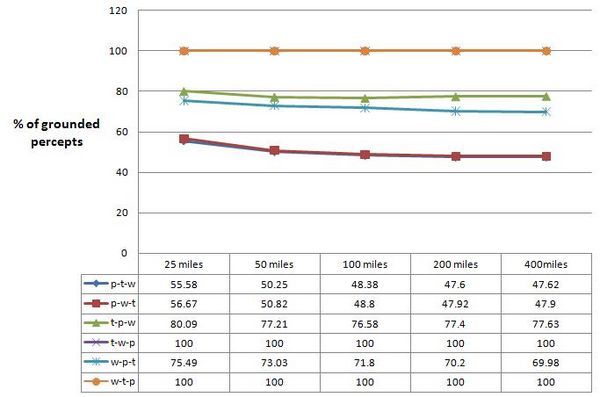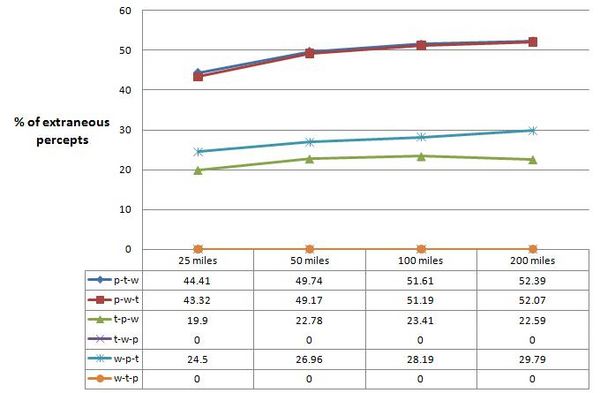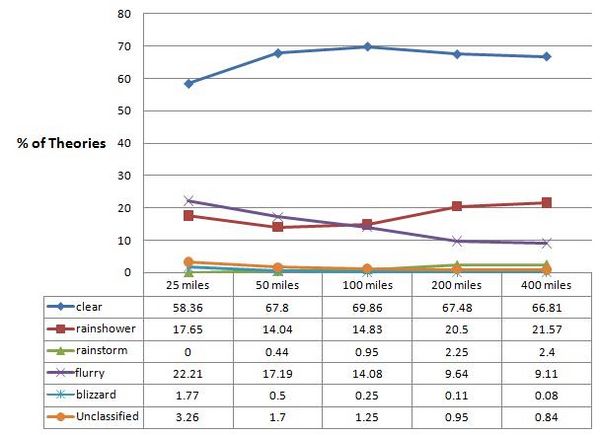Difference between revisions of "ISWC2010 Evaluation"
(→System Architecture) |
|||
| (37 intermediate revisions by 3 users not shown) | |||
| Line 1: | Line 1: | ||
| − | == | + | ==Ontology of Perception: A Semantic Web Approach to Enhance Machine Perception== |
| − | + | Today, many sensor networks and their applications employ a brute force approach to collecting and analyzing sensor data, and ignore the semantics inherent in the environmental data. Such an approach often wastes valuable resources – including both energy and computational resources – by unnecessarily tasking sensors and generating observations of minimal use. People, on the other hand, have evolved sophisticated mechanisms to efficiently perceive their environment. Such mechanisms include the use of background knowledge to determine what aspects of the environment to focus and a strong interdependent relationship between our ability to observe and perceive. In this paper, we develop an ontology of perception – derived from cognitive theory – that may be used to more efficiently convert observations into perceptions. We evaluate this approach by collecting and analyzing observations of weather conditions, and show up to 50% reduction in the number of observations necessary for analysis. | |
| − | |||
| − | |||
==System Architecture== | ==System Architecture== | ||
| − | |||
| − | |||
| − | [[Image: | + | <strong>Perception Cycle</strong> |
| + | [[Image:perception_cycle_new.jpg|none|thumb|500px| Figure 1. Perception Cycle.]] | ||
| − | [[Image: | + | <strong>Perception Process</strong> |
| + | [[Image:perception_process_new.jpg|none|thumb|500px| Figure 2. Perception Process.]] | ||
| − | + | <strong>Observation Process</strong> | |
| + | [[Image:observation_process_new.jpg|none|thumb|300px| Figure 3. Observation Process.]] | ||
| − | |||
| − | |||
| − | ==Ontologies== | + | ==Ontologies and Knowledge Bases== |
| + | |||
| + | <strong>Weather Background Knowledge</strong> | ||
| + | [[Image:bipartite_graph_black.jpg|none|thumb|600px| Figure 4. ]] | ||
| + | * [http://sonicbanana.cs.wright.edu/activeperception/ont/weather.owl Weather Background Knowledge] | ||
| + | * [http://wiki.knoesis.org/index.php/SSW_Datasets Observation Knowledge Base] | ||
| + | * [http://sonicbanana.cs.wright.edu/activeperception/ont/perception.owl Perception Ontology] | ||
| + | * Perception Datasets: | ||
| + | **[http://sonicbanana.cs.wright.edu/activeperception/all_active_25miles.zip 25 miles (17 observers)] | ||
| + | **[http://sonicbanana.cs.wright.edu/activeperception/all_active_50miles.zip 50 miles (70 observers)] | ||
| + | **[http://sonicbanana.cs.wright.edu/activeperception/all_active_100miles.zip 100 miles (170 observers)] | ||
| + | **[http://sonicbanana.cs.wright.edu/activeperception/all_active_200miles.zip 200 miles (373 observers)] | ||
| + | **[http://sonicbanana.cs.wright.edu/activeperception/all_active_400miles.zip 400 miles (516 observers)] | ||
| − | |||
| − | |||
| − | |||
| − | |||
==Statistics== | ==Statistics== | ||
| + | |||
| + | ====Percepts Generated during Evaluation: # and %==== | ||
| + | (p = precipitation, t = temperature, w = wind speed) | ||
| + | |||
| + | |||
| + | <strong>25 miles (17 observers)</strong> | ||
| + | [[Image:25miles.jpg|none|thumb|600px| Figure 5. ]] | ||
| + | <strong>50 miles (70 observers)</strong> | ||
| + | [[Image:50miles.jpg|none|thumb|600px| Figure 6. ]] | ||
| + | <strong>100 miles (170 observers)</strong> | ||
| + | [[Image:100miles.jpg|none|thumb|600px| Figure 7. ]] | ||
| + | <strong>200 miles (373 observers)</strong> | ||
| + | [[Image:200miles.jpg|none|thumb|600px| Figure 8. ]] | ||
| + | <strong>400 miles (516 observers></strong> | ||
| + | [[Image:400miles.jpg|none|thumb|600px| Figure 9. ]] | ||
| + | |||
| + | |||
| + | ====Percepts Generated during Evaluation: Trends==== | ||
| + | |||
| + | <strong>Grounded Percepts</strong> | ||
| + | [[Image:trend_grounded.jpg|none|thumb|600px| Figure 10. ]] | ||
| + | <strong>Extraneous Percepts</strong> | ||
| + | [[Image:trend_extraneous.jpg|none|thumb|600px| Figure 11. ]] | ||
| + | |||
| + | |||
| + | ====Theories Generated during Evaluation==== | ||
| + | [[Image:trend_theory.jpg|none|thumb|600px| Figure 12. ]] | ||
Latest revision as of 16:31, 28 June 2010
Contents
Ontology of Perception: A Semantic Web Approach to Enhance Machine Perception
Today, many sensor networks and their applications employ a brute force approach to collecting and analyzing sensor data, and ignore the semantics inherent in the environmental data. Such an approach often wastes valuable resources – including both energy and computational resources – by unnecessarily tasking sensors and generating observations of minimal use. People, on the other hand, have evolved sophisticated mechanisms to efficiently perceive their environment. Such mechanisms include the use of background knowledge to determine what aspects of the environment to focus and a strong interdependent relationship between our ability to observe and perceive. In this paper, we develop an ontology of perception – derived from cognitive theory – that may be used to more efficiently convert observations into perceptions. We evaluate this approach by collecting and analyzing observations of weather conditions, and show up to 50% reduction in the number of observations necessary for analysis.
System Architecture
Perception Cycle
Perception Process
Observation Process
Ontologies and Knowledge Bases
Weather Background Knowledge
- Weather Background Knowledge
- Observation Knowledge Base
- Perception Ontology
- Perception Datasets:
Statistics
Percepts Generated during Evaluation: # and %
(p = precipitation, t = temperature, w = wind speed)
25 miles (17 observers)
50 miles (70 observers)
100 miles (170 observers)
200 miles (373 observers)
400 miles (516 observers>
Percepts Generated during Evaluation: Trends
Grounded Percepts
Extraneous Percepts
